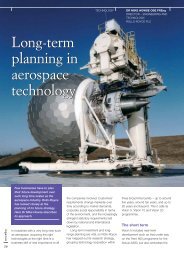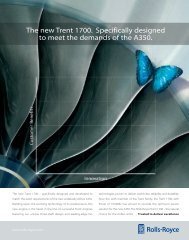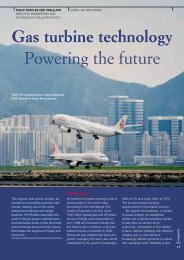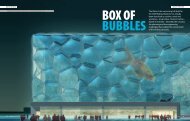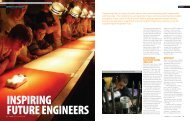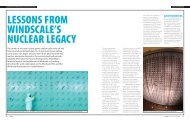MACROBERT AWARD 2009 - Ingenia
MACROBERT AWARD 2009 - Ingenia
MACROBERT AWARD 2009 - Ingenia
Create successful ePaper yourself
Turn your PDF publications into a flip-book with our unique Google optimized e-Paper software.
INNOVATION<br />
<strong>MACROBERT</strong> <strong>AWARD</strong> <strong>2009</strong><br />
The Royal Academy of Engineering’s MacRobert Award is the UK’s premier prize for<br />
engineering. It is awarded annually for an outstanding innovation, of benefit to the<br />
community, which has also achieved commercial success. It seeks to demonstrate the<br />
importance of engineering, and the role of engineers and scientists in contributing to<br />
national prosperity and international prestige.<br />
Described at its launch as “the Nobel Prize for engineering”, the Award was originally<br />
founded by the MacRobert Trusts and first presented in 1969. Every submission is<br />
reviewed by a panel of judges drawn from the Academy’s Fellowship and from all areas of<br />
engineering. The Award honours the winning company with a gold medal and the team<br />
members with a prize of £50,000. Here we showcase the four finalists for the award, starting<br />
with this year’s winner, announced at the Academy Awards Dinner on 9 June <strong>2009</strong>.<br />
INGENIA ISSUE 39 JUNE <strong>2009</strong><br />
13
<strong>MACROBERT</strong> <strong>AWARD</strong> <strong>2009</strong> WINNER<br />
BEIJING NATIONAL AQUATICS CENTRE ARUP<br />
Built to showcase the swimming events in the 2008 Olympics, the Beijing National<br />
Aquatics Centre, affectionately known as the Water Cube, has become one of the<br />
most recognisable, as well as energy efficient, buildings in the world.<br />
Unveiled to the billions of<br />
viewers watching the 2008<br />
Beijing Olympics, the Water<br />
Cube (officially known as the<br />
Beijing National Aquatics<br />
Centre), with its distinctive<br />
soap bubble appearance, is<br />
one of the flagship buildings<br />
in the regeneration of Beijing,<br />
incorporating cutting-edge<br />
construction materials and<br />
design techniques.<br />
INNOVATION<br />
The decision to give the<br />
Aquatics Centre a naturalistic<br />
appearance was made early<br />
on in the project, designed to<br />
complement the nearby Bird’s<br />
Nest stadium with its brackenlike<br />
tangle of criss-crossing<br />
beams. It was also decided<br />
at an early stage to use ETFE,<br />
a transparent Teflon-related<br />
material, as cladding because<br />
it was lightweight and offered<br />
better insulation than singleglazed<br />
glass.<br />
The use of EFTE as a<br />
material allows the Water<br />
Cube to use 30% less energy<br />
than comparable buildings,<br />
making use of the sun’s rays to<br />
heat the swimming pools and<br />
using natural air circulation to<br />
regulate internal temperatures.<br />
DEVELOPMENT<br />
The greatest challenge at the<br />
design stage was to find a<br />
method to produce a cladding<br />
that fitted together in a<br />
geometrically efficient manner<br />
and, at the same time, remain<br />
visually inspiring. After much<br />
research, the Arup team settled<br />
on a solution that combined<br />
19th century research into the<br />
three-dimensional geometry of<br />
soap bubbles and a technique<br />
to define the most efficient way<br />
of dividing a three-dimensional<br />
space – Weaire-Phelan foam.<br />
An interesting point about<br />
Weaire-Phelan foam is that,<br />
despite its uniform structure,<br />
when viewed at an arbitrary<br />
angle it appears totally<br />
random and organic. Using<br />
computational algorithms<br />
developed specifically for<br />
the project and advanced<br />
virtual prototyping, the result<br />
was a structure formed by<br />
interconnecting steel tubes and<br />
covered in inflated ETFE cells<br />
– of which there were seven<br />
different sizes measuring up to<br />
9m across.<br />
COMMUNITY<br />
BENEFIT<br />
Energy efficiency and<br />
sustainability are at the heart of<br />
the Water Cube’s design. The<br />
building essentially acts as a<br />
greenhouse; its ETFE cushions<br />
let high levels of natural<br />
daylight into the building,<br />
allowing the use of the sun to<br />
passively heat the pool water.<br />
Excess heat is stored by the<br />
internal surfaces and released<br />
at night, keeping temperature<br />
loads stable. The transparent<br />
ETFE panels also reduce<br />
artificial lighting requirements<br />
by 55%.<br />
The Water Cube was<br />
designed to be a sustainable,<br />
lasting legacy for the people<br />
of Beijing. Costing a fifth of an<br />
equivalent facility in the UK,<br />
the Water Cube is the start of<br />
a quiet revolution in building<br />
design. The use of multidisciplinary<br />
virtual prototyping<br />
and a holistic approach to<br />
performance optimisation<br />
means the construction<br />
industry can adopt an off-theshelf<br />
approach and match<br />
manufacturing sectors like the<br />
automotive industry in terms of<br />
cost, quality, and reliability.<br />
For further information, see<br />
www.arup.com<br />
The Water Cube has become a landmark building in Beijing, where it was constructed for the 2008 Olympics © Arup<br />
14 INGENIA ISSUE 39 JUNE <strong>2009</strong>
INNOVATION<br />
MEDICAL IMPLANTS FOR DUAL-TISSUE<br />
REGENERATION ORTHOMIMETICS<br />
Orthomimetics (OM) is working at the leading edge of regenerative medical<br />
technology and has developed novel implants for the regenerative repair of bone,<br />
cartilage, ligaments and tendons that are commonly damaged during sports injuries<br />
and other trauma. By helping surgeons repair damage to these tissues more<br />
effectively, OM’s products hold the potential to restore patient mobility, reduce the<br />
future risk of osteoarthritis, and delay the need for joint replacement surgery.<br />
Degenerative joint disease is<br />
one of the most costly and<br />
widespread challenges facing<br />
healthcare providers each<br />
year. Although total joint<br />
replacement can effectively<br />
restore mobility and alleviate<br />
pain, the clinical reality is that<br />
knee and hip prostheses last on<br />
average only 17 years. Younger<br />
patients sometimes require<br />
one, or sometimes multiple<br />
revision procedures to repair<br />
or replace failed implants.<br />
INNOVATION<br />
OM’s innovative implant<br />
technology, including<br />
its flagship product<br />
Chondromimetic, is the<br />
product of research<br />
collaboration between the<br />
University of Cambridge and<br />
the Massachusetts Institute<br />
of Technology. Based on a<br />
technology platform for the<br />
production of materials that<br />
mimic natural tissue, OM’s<br />
novel implants encourage the<br />
separate yet simultaneous<br />
regeneration of soft tissues<br />
(such as cartilage, ligament and<br />
tendon) and the bone to which<br />
they are anchored.<br />
The implants – which are<br />
delivered using minimally<br />
invasive, single-step procedures<br />
– provide a distinctive off-theshelf<br />
approach to optimise the<br />
Chondromimetic, an implant for regenerating tissue, is currently undergoing clinical testing in Europe © Orthomimetics<br />
outcome of current surgical<br />
methods for repairing damage<br />
to articular joints. By helping<br />
surgeons treat damage to<br />
cartilage, ligaments and<br />
tendons more effectively<br />
when it is first observed, these<br />
implants hold the potential to<br />
prevent or delay the onset of<br />
degenerative joint disease.<br />
Chondromimetic has<br />
several advantages over<br />
competing products for<br />
treating small lesions in<br />
articular cartilage. Easily<br />
inserted using available surgical<br />
instruments, it anchors directly<br />
to bone and uses natural<br />
biomaterials which resorb at<br />
rates compatible with new<br />
tissue formation. It is supplied<br />
in an all-in-one procedure pack,<br />
which simplifies implantation<br />
and minimises risk of error.<br />
Preclinical testing has shown<br />
that Chondromimetic produces<br />
results superior to those of the<br />
leading product for the repair<br />
of bone and cartilage.<br />
COMMERCIAL<br />
SUCCESS<br />
In December 2008, OM<br />
received CE Mark approval for<br />
Chondromimetic, identifying<br />
that it has met European<br />
consumer safety and health<br />
requirements, and completing<br />
a crucial company objective<br />
within budget and ahead of<br />
schedule. Receipt of three<br />
high-profile grants from the<br />
UK Technology Strategy Board<br />
totalling over £2 million has<br />
allowed further development<br />
of a strong range of future<br />
products. The recruitment of<br />
a world-class medical advisory<br />
board has also successfully<br />
shaped OM’s pre-clinical and<br />
clinical programmes.<br />
The imminent closure<br />
of OM’s latest stock offering<br />
will allow the company to<br />
implement a comprehensive<br />
programme to enhance the<br />
clinical and commercial profile<br />
of Chondromimetic, with an<br />
ultimate benefit to a new<br />
generation of patients.<br />
For further information, see<br />
www.orthomimetics.com<br />
INGENIA ISSUE 39 JUNE <strong>2009</strong> 15
<strong>MACROBERT</strong> <strong>AWARD</strong> <strong>2009</strong> FINALIST<br />
TARSIER DEBRIS DETECTION SYSTEM<br />
QINETIQ<br />
Debris on runways is a critical factor in airport safety and costs operators<br />
around $4 billion globally each year in damage to aircraft engines. In response<br />
to this problem, technology company QinetiQ has created Tarsier, a system<br />
that revolutionises the way airport operators inspect their runways, leading to<br />
improved safety, more efficient operations, and greener airports.<br />
Foreign objects and debris<br />
(FOD) left on airport runways<br />
pose a significant safety risk,<br />
as seen with the loss of a<br />
Concorde aircraft in July<br />
2000 after it ran over a piece<br />
of metal on take-off from<br />
Paris Charles de Gaulle airport.<br />
Runways are typically inspected<br />
for FOD by eye from a moving<br />
vehicle four times a day.<br />
This method, however, is not<br />
ideal as it leaves large time<br />
gaps between inspections<br />
and there are difficulties<br />
inspecting at night.<br />
DEVELOPMENT<br />
Despite the shortcomings<br />
of visual inspections, there<br />
has never been a technical<br />
alternative. The Tarsier system<br />
changes that by allowing<br />
runways to be monitored<br />
continuously day and night.<br />
Typically, two or three static<br />
radar towers are required to<br />
cover a complete runway,<br />
24 hours a day, in almost<br />
any weather.<br />
At the core of the Tarsier<br />
system is a new millimetre<br />
wave radar designed by<br />
QinetiQ specifically for FOD<br />
detection. Using an innovative<br />
and patented technique, it<br />
offers higher resolution, clarity,<br />
and accuracy than any other<br />
airport radar. It is capable of<br />
imaging items the size of a steel<br />
bolt at up to a kilometre away.<br />
INNOVATION<br />
To allow an operator to assess<br />
the risk that an item poses,<br />
Tarsier includes a cued camera<br />
– a high magnification lens<br />
with colour and near-infra red<br />
cameras, along with a unique<br />
infra red illuminator for use<br />
in darkness. It is critical that<br />
the illuminator is safe to the<br />
naked eye, yet has the ability<br />
to ‘light up’ small objects from<br />
a distance. The novel design<br />
through which this is achieved<br />
is the subject of a current<br />
patent application.<br />
A ‘smart’ element of the<br />
system can automatically<br />
discriminate FOD from the<br />
background, through the<br />
use of patented signal<br />
processing. The operator<br />
can then visually identify FOD<br />
and determine whether or not<br />
it presents a threat to aircraft.<br />
Tarsier is able to detect metal,<br />
plastic, glass, rubber, and<br />
organic matter to within a few<br />
metres and provide accurate<br />
GPS coordinates for quick<br />
retrieval.<br />
COMMERCIAL<br />
SUCCESS<br />
QinetiQ’s Tarsier is the world’s<br />
first fully operational FOD<br />
detection system. The first<br />
system was sold to Vancouver<br />
International in 2006, and<br />
installations at Dubai, Doha,<br />
Heathrow, Providence Rhode<br />
Island, and RAF Boscombe<br />
Down have followed. The<br />
proving of Tarsier, technically<br />
and as a commercial<br />
proposition, has led aviation<br />
regulators in the US and<br />
Europe to begin planning the<br />
widespread introduction of<br />
FOD detection systems.<br />
The safety benefits to the<br />
travelling public that Tarsier<br />
brings are clear: constant<br />
inspection of the runway,<br />
rather than inspecting once<br />
every six hours, dramatically<br />
reduces the risk posed by FOD.<br />
In its two years in operation at<br />
Vancouver, Tarsier has found<br />
over 400 items, including<br />
several classed as ‘posing<br />
significant risk’.<br />
For further information, see<br />
www.qinetiq.com<br />
Two to three Tarsier towers continuously scan an airport runway to detect<br />
foreign objects and debris © QinetiQ<br />
16 INGENIA ISSUE 39 JUNE <strong>2009</strong>
INNOVATION<br />
TRENT 900 GAS TURBINE ENGINE<br />
ROLLS-ROYCE PLC<br />
The development of the Airbus A380 ‘super-jumbo’ set a new level of required<br />
standards for aircraft engines. Rolls-Royce’s Trent 900 was chosen to be the<br />
launch engine for the A380 due to its exceptional fuel economy, low noise,<br />
and advanced monitoring and maintenance systems.<br />
Since entering service on<br />
the Airbus A380, the hightechnology<br />
Trent 900 has<br />
been demonstrating significant<br />
environmental and operational<br />
benefits.<br />
DEVELOPMENT<br />
Having achieved the honour<br />
of being the launch engine<br />
on this flagship programme,<br />
environmental considerations<br />
were placed at the core of<br />
the product’s development.<br />
To meet these challenges,<br />
Rolls-Royce married the<br />
successful engineering<br />
heritage of the established<br />
Trent engine family with an<br />
extensive suite of innovative<br />
new technologies.<br />
INNOVATION<br />
The Trent 900 features<br />
novel ‘swept’ fan blades<br />
to ensure high levels of<br />
propulsive efficiency while<br />
minimising noise. Advanced<br />
analytical techniques enabled<br />
integration of low-noise<br />
generating aerofoils with<br />
improved duct designs for<br />
greater noise reduction.<br />
Coupled with an innovative<br />
low-pressure turbine design,<br />
these technologies have been<br />
instrumental in the aircraft<br />
meeting stringent noise<br />
specification targets for takeoff<br />
and significantly bettering<br />
targets for noise on landing.<br />
A focus on environmental<br />
concerns led to significant<br />
improvements in both fuel<br />
consumption and emissions.<br />
The incorporation of a contrarotating<br />
high-pressure shaft<br />
system has significantly<br />
reduced aerodynamic<br />
losses and reduced the<br />
number of internal<br />
components. Rolls-Royce also<br />
used advanced aerodynamic<br />
techniques to define optimised<br />
3D compressor and highpressure<br />
turbine aerofoils.<br />
Together with the<br />
development of a novel tiled<br />
combustor, these innovations<br />
secured the engine’s high<br />
performance while meeting all<br />
foreseen emissions regulations<br />
and competitive challenges.<br />
Through this comprehensive<br />
approach, the Trent 900 has<br />
succeeded in delivering<br />
performance improvements<br />
equivalent to reductions of<br />
$1.3 million in fuel costs and<br />
6,150 tonnes of emitted carbon<br />
dioxide per aircraft per year.<br />
This spirit of innovation<br />
has also extended into<br />
the operational arena.<br />
The engine is equipped with<br />
a health monitoring system<br />
that enables remote analysis<br />
of engine performance.<br />
This allows early identification<br />
of potential issues and the<br />
preparation of maintenance<br />
activity even before the aircraft<br />
lands. Uniquely, the Trent<br />
The first Trent 900 engine being tested in 2003 © Rolls-Royce Plc<br />
900 engine was designed to<br />
be transported whole in a<br />
Boeing 747 freighter aircraft,<br />
enabling operators to rapidly<br />
deploy engines to support their<br />
operational needs.<br />
COMMERCIAL<br />
SUCCESS<br />
The Trent 900 continues to<br />
be the engine of choice for<br />
the A380, with 58% market<br />
share, over 400 engine orders<br />
and selection by 10 of the 13<br />
operators who have placed<br />
orders for A380 aircraft.<br />
The Trent 900 entered<br />
service with the A380 launch<br />
customer, Singapore Airlines, in<br />
October 2007. Since then, the<br />
engine has accumulated over<br />
120,000 hours of operation with<br />
Singapore Airlines and, more<br />
recently, Qantas. Entry into<br />
service has been exceptional<br />
with operational statistics<br />
leading the launch airline to<br />
comment on the programme<br />
as its “smoothest ever” entry<br />
into service.<br />
For further information, see<br />
www.rolls-royce.com<br />
INGENIA ISSUE 39 JUNE <strong>2009</strong> 17



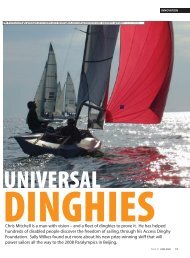

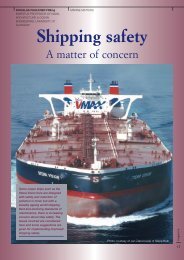
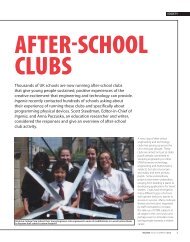

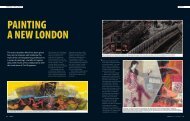
![[322/03] Francke - Ingenia](https://img.yumpu.com/23411337/1/184x260/322-03-francke-ingenia.jpg?quality=85)

